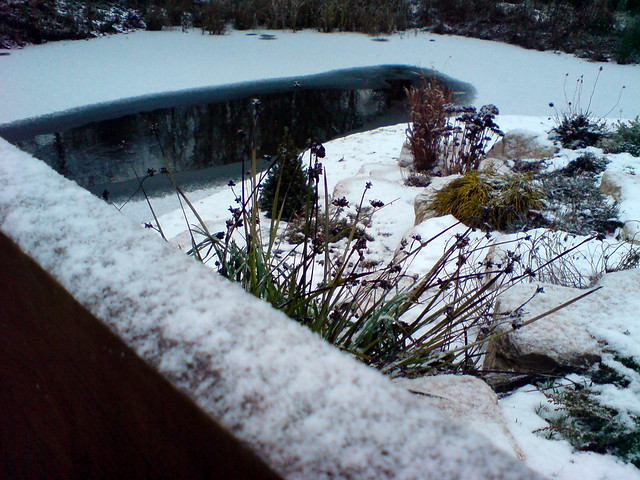If you live in a northern climate then chances are good that you see snow and ice as does your koi pond. Its natural to worry about your koi during the winter periods, especially if they have been around for years and years. Fortunately, koi are adapted to dealing with cold temperatures and an iced-over pond. They have a few tricks up their "sleeves" to deal with the inevitability of ice cold water.
 |
| Photo by Hulk, Smash! |
Regulating Body Temperature
Thermoregulation of animals or how an animal regulates its body temperature can be a confusing subject. For example, within the subject of thermoregulation there is:
- Ectothermic
- Endothermic
- Mesothermic
- Heterothermic
- Homeothermic
- Poikilothermic
- "Cold-blooded"
There's a lot of variations in the world of temperature regulation in animals but to make it more straightforward for koi owners you should know that your fish are ectothermic,which means that their internal body temperature is governed strictly by the ambient temperature (or in this case, the water temperature). So that must mean that all fish are ectotherms, right? Not necessarily. Unfortunately, biology is not always consistent.
For example, the bluefin tuna and some sharks create internal heat from muscle activity yet are still largely affected by water temperature which puts them in a category known as mesothermy. Furthermore, the term "cold-blooded" is actually not all that accurate. A "cold-blooded" lizard in the hot desert sun can achieve an internal temperature greater than that of humans. So in everyday conversation its just easier to refer to mammals and birds as endotherms and just about everything else as ectotherms.
Biological Activity and Temperature
You have probably noticed throughout the seasonal changes that as the water temperatures get colder your fish start to become less active. As a result, they require less food and at somewhere between 50 and 40 degrees F they stop eating all together. Ectotherms are able to pull this off because they don't have to maintain a certain internal temperature and, in fact, they can get away with using as little as 10% of the energy of what a mammal would need. As temperatures fall, the rate of internal biological activity decreases which includes things as basic as how fast a muscle can twitch. This concept in biology is known as the Q-10 coefficient.
Planning for Winter
There's not much activity going on with your fish, on the inside or outside. They don't need food and not as much oxygen however its still a good idea to keep some of your pond unfrozen with a de-icer for gas exchange (and some pond owners will run aeration all year long).
One of the things your koi will do is try to hang out in the warmest part of the pond and that will subsequently be the deepest part. In general though, its a good idea, when designing/building a koi pond, that you make it at least 3 feet deep to avoid the possibility of total pond freeze. Another thing you may want to keep in mind is that adding salt to your pond before winter will lower the freezing point of water and artificially cause your water to reach a super low temperature which can potentially harm your koi.
Koi in Dormancy
So what exactly are they doing under the ice? Sleeping? Playing cards? As with thermoregulation there are a lot of different ways to go inactive during winter (or periods of less-than-ideal conditions).
There is:
hibernation in mammals
brumation in reptiles
diapause in insects and
aestivation in invertebrates
brumation in reptiles
diapause in insects and
aestivation in invertebrates
but ultimately your koi under ice are in a state of dormancy. Essentially, they are simply "chilling out" in a state of super decreased activity and metabolism while waiting for spring. Perhaps you don't get to enjoy your koi as they mill around under the ice but just think of the money you are saving not buying koi food!
Have you ever wondered what happens to your koi with the onset of winter? What are they doing under an iced over pond? Are they hungry and looking for food? In this article I discuss the physiological and biological changes that occur to your fish with the onset of cold water. I also discuss simple things you can do to prepare your pond for ice that will make it the most comfortable for your koi. If you're wondering about your fish in winter even how to change the way you feed in fall ( http://koi-care.com/feeding-koi-water-temperatures-change/ ) then please see more at my site. Thanks for stopping by! Article Source: EzineArticles |

No comments:
Post a Comment